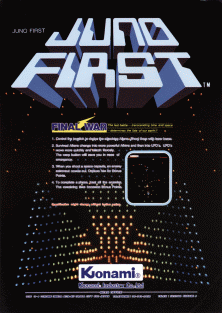Top Qs
Timeline
Chat
Perspective
Juno First
1983 video game From Wikipedia, the free encyclopedia
Remove ads
Juno First (ジュノファースト) is a 1983 fixed shooter video game developed and published by Konami for arcades; in North America, it was distributed by Mylstar Electronics. The game is a shooter with a slightly tilted perspective, similar to Nintendo's 1980 game Radar Scope.[3] The game was ported to the MSX, Commodore 64, Atari 8-bit computers, and IBM PC.
This article needs additional citations for verification. (January 2011) |
Remove ads
Gameplay
This section may be confusing or unclear to readers. (May 2015) |
Juno First presents a set number of enemies per level, but they do not make a gallery formation like Galaga or Space Invaders. Instead, the player's ship can move forward and backward (in addition to left and right) to hunt enemies in an orientation that is vertical, but has some horizon-oriented tilt. This style of gameplay would be re-used in a later Konami shooter, Axelay.
The player destroys waves of enemies to finish levels. Starting formations vary from stage to stage. In addition, the player can pick up a humanoid, upon which the screen will have a red tint. While this happens, every enemy the player shoots will earn the player 200 more points than the previous enemy destroyed. The original score for shooting an enemy while in humanoid mode depends on the stage.
Remove ads
Ports
Juno First was first ported in the western market to the Commodore 64, Atari 8-bit computers, and IBM PC in 1984. All of these ports were handled by Datasoft. The Commodore and Atari ports were programmed by Greg Hiscott, while the IBM version was programmed by Scott Titus.[citation needed]
In Japan, Sony released a conversion of Juno First in 1983 for MSX computers. This version soon made its way to other MSX markets as well.[citation needed]
Juno First was included via Microsoft's Game Room service for the Xbox 360 and Windows on June 30, 2010.[citation needed] It was also included as part of the Arcade Archives series for the PlayStation 4 and Nintendo Switch on March 13, 2025.[4]
Remove ads
Legacy
An unofficial hobbyist port—with the same name as the original—was made available for the Atari 2600.[5]
See also
- Beamrider (1983)
References
External links
Wikiwand - on
Seamless Wikipedia browsing. On steroids.
Remove ads

